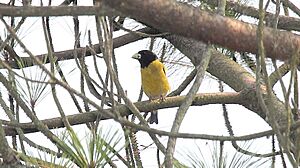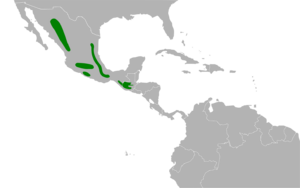Hooded grosbeak facts for kids
Quick facts for kids Hooded grosbeak |
|
|---|---|
 |
|
| Conservation status | |
| Scientific classification | |
| Genus: |
Hesperiphona
|
| Species: |
abeillei
|
 |
|
| Synonyms | |
|
|
The hooded grosbeak (scientific name: Hesperiphona abeillei) is a fascinating songbird. It belongs to the finch family, known for their strong, cone-shaped beaks. You can find these birds living in the high mountain areas of Central America. They are mostly seen in Mexico and Guatemala.
Meet the Hooded Grosbeak
This bird is a medium-sized grosbeak. It has a very large and powerful bill. This strong beak helps it crack open tough seeds and nuts. The male hooded grosbeak is quite striking. He has a shiny black head. His upper body is covered in bright yellow feathers. The female looks a bit different. She has softer colors. Her black cap is also smaller than the male's. This makes her less brightly colored.
Where Do These Birds Live?
Hooded grosbeaks prefer to live in the highlands. These are mountainous regions in Central America. They are commonly found in the forests of Mexico. You can also spot them in the mountains of Guatemala. These birds enjoy environments with plenty of trees. They thrive in the cooler air of higher elevations.
How Scientists Named This Bird
A French naturalist named René Lesson first described this species. He wrote about it in 1839. He gave it the scientific name Guiraca abaillei at that time. Scientists use special names to identify each unique species. Today, the International Ornithologists' Union classifies the hooded grosbeak. They place it in the genus Hesperiphona. This genus also includes the closely related evening grosbeak. Another French ornithologist, Charles Lucien Bonaparte, introduced this genus in 1850.


